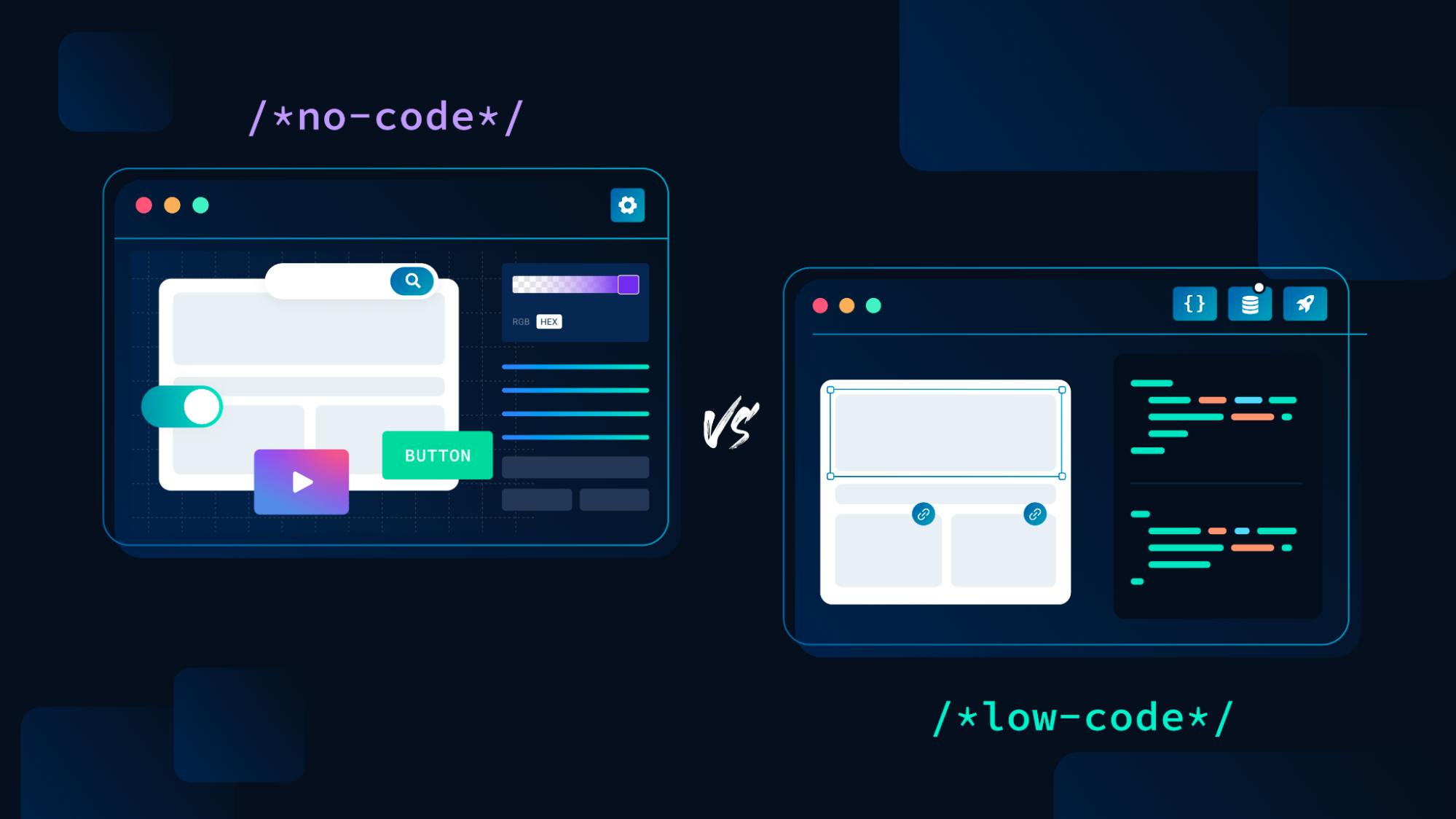Low-Code Is Here to Stay!


With the growing demand for more complex apps and a shortage of developers all around the world, there's a lot of buzz around no-code & low-code development. Companies are realizing that these tools can enable them to ship faster.
These tools rely less on code from scratch and more on visual editing and AI to solve problems and enable builders. Such software falls under the category of “No-code” and “Low-code”. While no-code tools require little to no coding knowledge, low-code ones demand coding experience to make good use of them.
No-code tools are a lifesaver for builders who don’t want to code their solutions and want to rapidly build apps and add third-party integrations. This makes it an ideal choice for quickly rolling out proofs-of-concept and apps that don’t require in-depth customizations.
On the other hand, we have low-code tools that are geared toward technical builders, who want to create complex designs and systems but don’t want to start from scratch.
These tools have taken the app development market by storm and research shows that by 2025, 70% of the apps will use low-code tools in their development.
Why are Low-Code Tools in Demand?
Low-code tools give users more flexibility as compared to no-code ones by allowing them to access, edit & write the code behind the interface and functions and also try to fit into the existing workflows, tools, and stacks.
These apps also provide a host of integrations, plugins, and features out-of-the-box, just like no-code tools, however, the ability to offer deeper customizations in the form of custom code snippets, integrating with different tech stacks by generating extendible code in various frameworks as well as the flexibility in terms of designs differentiate low-code tools from no-code counterparts.
For example, a low-code tool such as AppSmith allows users to build internal dashboards and pages instantly by pulling data from their database, CMS, and APIs via templates & built-in widgets and at the same time, it also enables them to add logic and validation via JavaScript.
Many well-known apps are built using these tools. Household names like Amazon and Uber are some of the many that use low-code software like Retool, Twilio & Braintree internally instead of reinventing the wheel.
There are several benefits offered by these low-code tools that attract builders, some of which are:
Incredible Flexibility
One of the most common cons of no-code tools is that the users are limited by the constraints of the platform. For instance, if you want to change the radius of a button but your tool doesn’t allow it, then there is nothing you can do about it except abandon the tool & move to an alternative that may offer such customization.
Low-code tools, as the name suggests, support custom code snippets and are extensible, so users can easily implement their custom designs, user flows, and third-party integrations.
Freedom & Ownership
Often times these low-code tools are either open source or allow users to export the final output so they can tweak it further and self-host them.
This is a huge feature for developers & teams who don’t like linking their sensitive data & building on tools that they don’t trust. When you have the code or the final output in hand, you can extend it, break it into modules and use it as a base on top of which you can iterate and add features.
Additionally, well-thought-out tools also provide options to customize the output such as offering multiple frameworks and styling options.
Accelerate the Development Phase
With all the new products coming out daily, time to market is now more critical than ever. These tools & apps help developers simplify their workflow and roll out new updates, prototypes, and products faster than ever.
Using them, you can ship complex features like authentication, connect different apps, & add video streaming among other in-demand features in record times. Apps like Zapier allow you to connect over 5000 apps for advanced, automated workflows.
Rich Apps & Complex Functions
By helping developers implement most of the trending features like single sign-on(SSO), static front-end code generation, & generating content via AI, it frees them to focus more on what matters: their product’s unique selling proposition.
This helps developers reclaim their time and focus on complex and distinguishing features of their app while using low-tools tools to implement the common and expected functionalities.
Furthermore, oftentimes these tools can actually aid developers in creating complex functions by providing them with an environment to easily test & experiment with different features and properties. Storybook, for instance, allows design teams to isolate UI components and test & present them individually.
Popular Use Cases
Websites
Building, hosting, and updating websites have been one of the most common and popular use cases of these tools. Tools like WordPress are the earliest examples of low-code tools in action.
These days you can build sophisticated, dazzling websites without knowing anything about UI designs and systems or messing around with hosting and continuous integration pipelines.
Prototypes
Want to validate your idea before actually building it? Prototypes serve as an excellent choice to build a visual representation of your vision before you write even a single line of code.
With tools like Figma, you can build high-fidelity prototypes that will be a reflection of your end products and present it to your users to collect feedback.
Data Management & Analysis
Airtable has greatly simplified how we perceive & work with databases by combining the scalability of databases with the friendliness of spreadsheets.
Similarly, other tools in the space have also stepped up and popularized data analysis. Tools like Dataiku have made big data and artificial intelligence much more accessible & one can easily add AI capabilities to their applications these days.
API and Backend Generation
Creating and managing APIs is a time-consuming and tedious process, however, luckily with software like Strapi, you can quickly build an API structure and connect your databases.
This allows you to add a backend for your frontend UI in no time. Moreover, it provides a clean content management system for you to easily add & edit content.
Internal Tools
Various low-code tools like Retool, Appsmith, etc have made it incredibly easy to build internal tools such as user dashboards, analytics, performance reviews, and more without spending weeks connecting databases and creating charts.
These tools integrate with your database and provide you with widgets such as charts, maps, tables, and forms to display, filter, and sort data.
Low-code is Dev-Friendly
Developers shouldn’t assume that with the rise of low-code tools their jobs are on the decline. Instead, they should leverage these tools to automate their workflow and accelerate the development process.
Additionally, these tools are not perfect to a fault and have several downsides as well such as difficulty in scaling, less security, and may have a steep learning curve. Therefore, these tools have only led to an increase in demand for more developers who specialize in creating & using them, making them coexist alongside the standard development tools in the market.
These tools complement the development phase and as discussed earlier, they free developers from working on features that have already been implemented time after time and spending their time on more productive matters.
The Locofy.ai plugin is one such tool that can save developers weeks by converting their designs in Figma and Adobe XD into pixel-perfect, production-ready front-end code in a matter of few hours. The code can be generated in popular frameworks such as React, Next.js, Gatsby, React Native, and HTML-CSS.
What’s more, is that the code is highly extendible & can be customized with top UI libraries.
This allows developers to zero in on interactivity and extend the code with APIs, and CMS, and ship products 5-10x faster.
